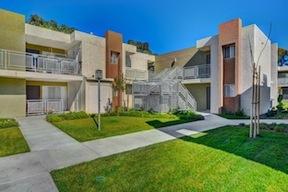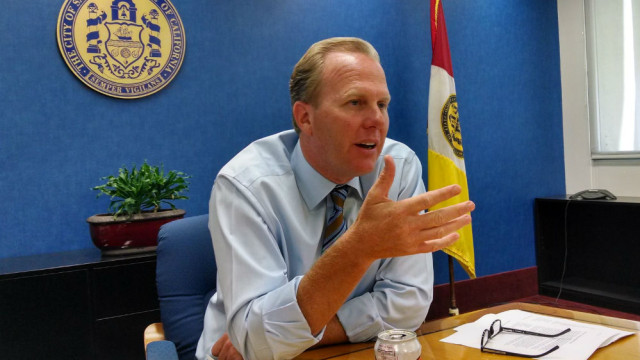Daily Business Report-June 2, 2015
Rendering of a proposed mixed-use stadium in Mission Valley.
City and County to Start Stadium
Negotiations With Chargers Today
Negotiations between the Chargers and city and county officials over a new stadium in San Diego are scheduled to begin Tuesday at an undisclosed location.
The talks come about two weeks after an advisory group appointed by Mayor Kevin Faulconer issued the framework of a financing plan that would raise $1.4 billion toward construction costs. The nine-member task force estimated a price tag of around $1.1 billion, leaving some wiggle room for discussions among the officials.
The Chargers have been pushing for a new playing facility for nearly 15 years to replace aging Qualcomm Stadium. The team recently purchased 157 acres in the Los Angeles suburb of Carson jointly with the Oakland Raiders, where they’ve proposed building a $1.7 billion, 72,000-seat stadium in case the National Football League franchises fail to achieve acceptable deals in their current cities.
The Chargers Stadium Advisory Group recommended building a 65,000-seat facility in Mission Valley adjacent to Qualcomm Stadium, which would eventually be razed to make the land available to a developer. The new stadium would also be home for San Diego State University’s football team, the Holiday and Poinsettia bowls, high school championships and special events.
The project would also include creation of a park running along the San Diego River.
The negotiations are expected to include finance and legal consultants on both sides, but the Chargers haven’t specified who will accompany chairman Dean Spanos and Mark Fabiani, who has served as the team’s special counsel and spokesman on stadium issues for many years.
The city and county of San Diego have each set aside $250,000 to pay their consultants — the legal firm Nixon Peabody, which has consulted on 25 stadium projects, and Citigroup, which has been involved in raising money to build stadiums recently in Atlanta, New York and Orlando.
Their goal is an agreement that would pass muster with voters in an election. The advisory group framework does not include a tax increase that triggers a requirement for a vote, but both the mayor and team officials have said they want the public to validate their plans if a deal is reached.
The time and location of the meeting have not been made available, and city officials have said they don’t plan on issuing frequent updates on their progress.
— City News Service
Grand Jury: San Diego Police
Need to Improve Evidence Procedures
The San Diego Police Department’s evidence- and property-handling procedures fall short of standards widely maintained by other area law enforcement facilities, according to a report released Monday by the 2014-15 county grand jury.
In its review, the panel also decried a purported lack of communication among the district attorney, city attorney and the SDPD concerning the retention or disposal of evidence. The deficiency at times causes items to be retained after cases are closed, resulting in a need for extra storage space and leading to delays in returning property to its rightful owners.
The police department did not immediately respond to a request for reaction to the set of critiques.
The jury’s probe was prompted by published reports concerning the manner in which SDPD personnel maintain evidence in their custody, how it was accounted for and whether property was promptly returned or disposed of when no longer needed, according to county officials.
The thrust of the investigation was to determine if the department made use of procedures to properly handle and store evidence needed for trials and to dispose of it when appropriate.
To improve the situation, the district attorney and San Diego city attorney should work with the police department to develop better communication as to when evidence is no longer needed, the grand jury recommended.
The panel also advised that the SDPD perform a management review based on Peace Officers Standards and Training guidelines to identify weaknesses in property and evidence procedures and to implement corrective action.
— City News Service

Researchers Find Gene Mutation
That Strips Color, Reduces Vision
People with achromatopsia, an inherited eye disorder, see the world literally in black and white. Worse yet, their extreme sensitivity to light makes them nearly blind in bright sunlight. Now, researchers at UC San Diego School of Medicine and Shiley Eye Institute at UC San Diego Health System have identified a previously unknown gene mutation that underlies this disorder.
The study was published online June 1 in the journal Nature Genetics.
“There are whole families with this sort of vision problem all over the world,” said Jonathan Lin, senior study author and an associate professor in the UC San Diego School of Medicine Department of Pathology. “We’re very excited to have discovered a mutation in the ATF6 gene which plays a major role in this disorder.”
Five other genetic mutations have previously been identified by research groups as pivotal in achromatopsia, which causes markedly reduced visual acuity and very poor or no color vision. “But we still had families that didn’t have any of those gene mutations,” said Lin, also a researcher at the UC San Diego Shiley Eye Institute. “We knew this meant there must be other genes and proteins involved.”
The study, which involved an international collaboration of inherited retinal disease specialists, found that a mutation in the ATF6 gene damaged proteins necessary for proper function of the eye’s cone photoreceptors. The eye has millions of these receptors, which control color recognition and daytime vision.
In achromatopsia, malfunction of the cone photoreceptors causes sufferers to be either totally or predominantly colorblind. This type of colorblindness is different from the more common version, which makes some people unable to distinguish between red and green. “Achromatopsia sufferers see images on the gray scale,” explained Lin.
The finding is exciting because it provides an opportunity to eventually develop a treatment. Currently, there is no cure or treatments for achromatopsia. “It’s early days yet,” saidLin. “But pinpointing the genetic cause allows us to focus on finding a way to block this mutation. Clinical trials are already in the works to fix one of the other mutated genes, and gene therapy is also under investigation.”
Xpera Group Launches Real Estate
Repositioning Division, Xpera RE
San Diego-based Xpera Group has launched a new service division — Xpera RE — that focuses on the repositioning and renovation of income-generating properties. The division builds on the expertise of Xpera Group and its construction subsidiary, which have been involved in renovating more than 100 multi-family housing communities throughout Southern California.


Xpera RE is led by Chief Operating Officer Neal Singer. The division will focus primarily on multi-unit residential properties, including apartments, senior housing, hotels and dormitories.
Nevin, market research director for Xpera RE, said there are 300,000 apartment units in San Diego County alone, with an average age of 41 years. Few of the aging units have been renovated and the vast majority of them lack an in-unit washer/dryer and air conditioning. Most need a substantial renovation to bring them up to modern standards, according to Nevin.
Xpera RE has partnered with the San Diego County Apartment Association to hold an educational seminar on the apartment repositioning and renovation process on Tuesday, June 23, from 11 a.m. to 2 p.m. at the SDCAA offices. To register, visit www.sdcaa.com. All proceeds from the $50 ticket sales will benefit the organization’s scholarship fund.
Elevator Acquires Copper Blue Creative
Elevator, a Carlsbad-based digital brand strategy agency, has acquired Copper Blue Creative, a creative design company that also is based in Carlsbad.
Brian Haffeman, will become senior account strategist for Elevator. His agency, Copper Blue Creative, was established in 2008 and currently represents Coco’s Restaurant, Maderas Golf Course, The Crossings at Carlsbad, TaylorMade, Cafe Moto, Zensho, and Koloa Landing, among others.
Elevator represents a variety of clients, among them CO-OP Financial Services, The City of San Diego, Agena Bioscience, Watchlight Corporation, Cal-Am Properties, Lantronix, and Mitchell International. It was founded in 2004.
Personnel Announcements
Marcus & Millichap Hires Sales Manager

Colby Haugness has rejoined Marcus & Millichap as sales manager of its San Diego office. Haugness joined Marcus & Millichap’s Seattle office in 1999, specializing in retail property sales, and he was promoted to senior associate in October 2002.
Haugness left the firm in November 2003 to pursue other interests in real estate.
Haugness attended Washington State University where he studied real estate and finance.


